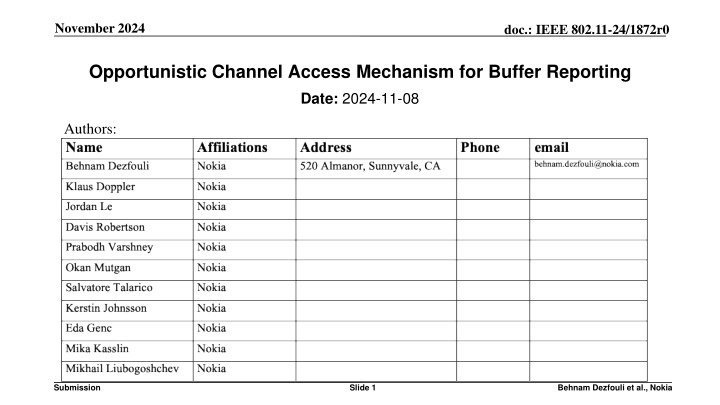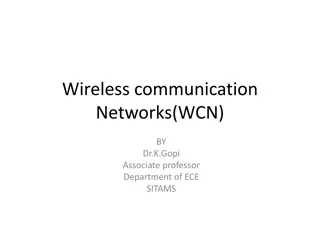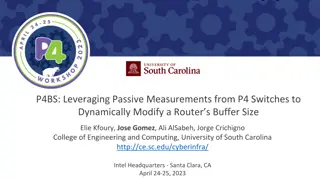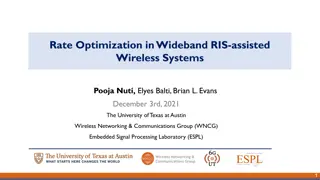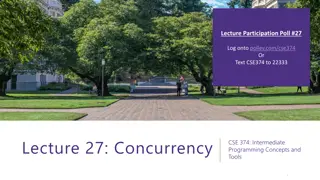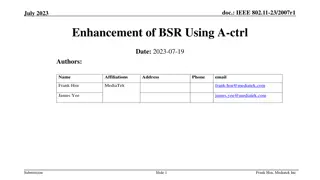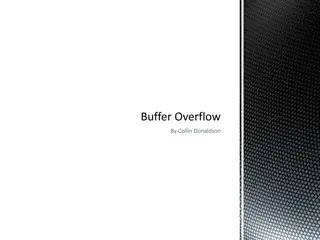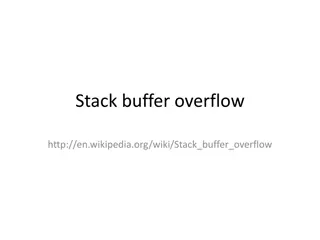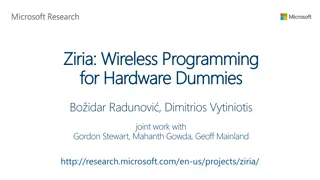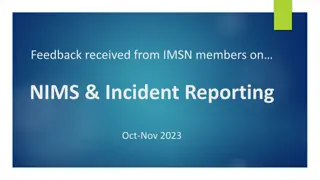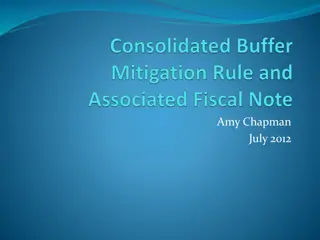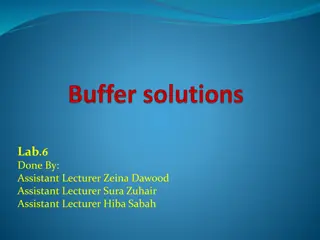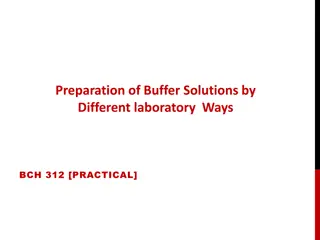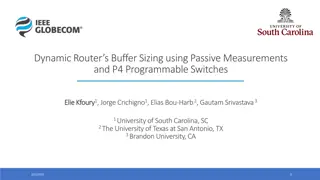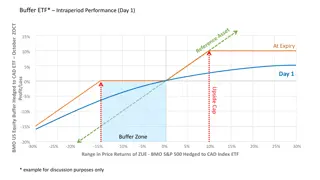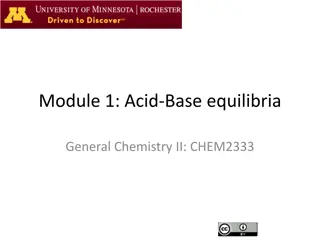Enhancing Wireless Communication Efficiency with Buffer Reporting Mechanism
This document discusses IEEE 802.11-24/1872r0, focusing on an Opportunistic Channel Access Mechanism for Buffer Reporting. It explores improving latency distribution and jitter in 802.11bn, especially for Low-Latency traffic. The concept of Buffer Report Requesting is introduced, allowing Access Points to gather real-time data on Station needs for resource allocation. Various methods for Low-Latency traffic exchange during TXOPs are presented, offering insights into enhancing communication efficiency in wireless networks.
Download Presentation

Please find below an Image/Link to download the presentation.
The content on the website is provided AS IS for your information and personal use only. It may not be sold, licensed, or shared on other websites without obtaining consent from the author.If you encounter any issues during the download, it is possible that the publisher has removed the file from their server.
You are allowed to download the files provided on this website for personal or commercial use, subject to the condition that they are used lawfully. All files are the property of their respective owners.
The content on the website is provided AS IS for your information and personal use only. It may not be sold, licensed, or shared on other websites without obtaining consent from the author.
E N D
Presentation Transcript
November 2024 doc.: IEEE 802.11-24/1872r0 Opportunistic Channel Access Mechanism for Buffer Reporting Date: 2024-11-08 Authors: Submission Slide 1 Behnam Dezfouli et al., Nokia
November 2024 doc.: IEEE 802.11-24/1872r0 Introduction UHR aims to provide more predictable delays and reduce tail latency One of the objectives of 802.11bn is: Enabling at least one mode of operation capable of improving the tail of the latency distribution and jitter compared to EHT MAC/PHY operation, with mobility between BSSs [11- 23/0480r3] For aperiodic low-latency (LL) traffic, the AP must have up-to-date information regarding the current needs of STAs to effectively allocate communication resources Buffer report requesting: the AP can actively request buffer report (e.g., BSR) from STAs Buffer report requesting can be employed during TXOPs, such as through TXOP sharing or TXOP preemption Submission Slide 2 Behnam Dezfouli et al., Nokia
November 2024 doc.: IEEE 802.11-24/1872r0 An Example Method of LL Traffic Exchange during TXOPs A sample application of buffer report requesting is during TXOPs While a STA is in possession of a TXOP (the "TXOP holder"), other STAs cannot use the channel to exchange Low-Latency (LL) traffic If the TXOP holder is the AP, it can use a portion of its acquired TXOP to poll non-AP STAs if they need to transmit UL LL traffic If the TXOP holder is a non-AP STA, it may share a portion of its TXOP with AP to send DL LL traffic or poll non-AP STAs if they need to transmit UL LL traffic Sample methods have been proposed in [11-24/0390r0] [11-24/0870r0] [11-24/629r0] [11-23/1886r3] [11-24/0168r0] [11-23/1874r0] Submission Slide 3 Behnam Dezfouli et al., Nokia
November 2024 doc.: IEEE 802.11-24/1872r0 An Example Method of LL Traffic Exchange during TXOPs TXOP Duration Transmission Period Transmission Period LL Traffic Exchange Non-AP STAX is the TXOP holder and communicates with the AP Non-AP STAX is the TXOP holder and communicates with the AP TXOP shared with the AP to perform LL traffic exchange Transmission Period refers to the intervals during which the TXOP holder oversees the TXOP and communicates with one or more responders LL Traffic Exchange refers to a period during which the AP can use the TXOP to perform LL traffic exchange with non-AP STAs The existing method to perform buffer report requesting is through polling The AP sends BSRP, and in response, the STAs respond with BSR frames [11-24/0168r0] [11- 24/0390r0] [11-23/2076r0] Submission Slide 4 Behnam Dezfouli et al., Nokia
November 2024 doc.: IEEE 802.11-24/1872r0 Problem Statement TXOP Duration Transmission Period LL Traffic Exchange Transmission Period During the LL Traffic Exchange period Phase 1: The AP needs to determine which STAs need to perform UL LL transmission Phase 2: UL, DL, or both types of communication are performed Determine the STAs with UL LL traffic UL/DL Traffic Phase 1: Phase 2: Exchange Phase 1 must be as short as possible to maximize the efficiency of utilizing LL Traffic Exchange period Polling non-AP STAs (e.g., BSRP/BSR) can be used to determine if they carry LL traffic Shortcoming: The duration of polling can be long, and its overhead depends on the number of STAs and available bandwidth [11-24/1870r0] Since the number of STAs with LL traffic is usually lesser than the total number of STAs in the network (e.g., 20%) , more efficient ways of sending buffer reports (BSRs) from the STAs are required We propose an efficient method for requesting and collecting buffer reports from STAs Submission Slide 5 Behnam Dezfouli et al., Nokia
November 2024 doc.: IEEE 802.11-24/1872r0 Opportunistic Buffer Reporting by STAs TXOP Duration Transmission Period LL Traffic Exchange Transmission Period We propose a structure named Buffer Status Collection Period (BSCP) This structure allows the AP to request and collect BSRs from STAs depending on the priority of their traffic Determine the STAs with UL LL traffic UL/DL Traffic Phase 1: Phase 2: Exchange Buffer Status Collection Period (BSCP) Sub-window 1 (e.g., AC_VO) Sub-window 2 (e.g., AC_VI) Initial Actions (IA) Final Actions (FA) Resource Units PIFS SIFS PIFS (RUs) e.g., 52-tone RU Time Submission Slide 6 Behnam Dezfouli et al., Nokia
November 2024 doc.: IEEE 802.11-24/1872r0 The Buffer Status Collection Period (BSCP) structure is composed of the following components 1. One or more sub-windows, where each sub-window is associated with one or more traffic Access Categories (ACs) 2. One or more RUs, where each RU may represent a number of tones Example: An RU may represent a 52-tone RU 3. Inter-Frame Spacing (IFS) between sub-windows, to allow the AP to modify or terminate the BSCP e.g., when enough BSR frames are received, the AP may immediately send a TF to schedule UL 4. An optional Initial Actions (IA) period at the beginning of the BSCP Allows the AP to send management or control frames to structure BSCP (signaling details TBD) e.g., the AP announces the structure of the BSCP, such as the number of RUs and number of timeslots 5. An optional Final Actions (FA) period at the end of the BSCP e.g., the AP sends a TF to schedule UL traffic from STAs Submission Slide 7 Behnam Dezfouli et al., Nokia
November 2024 doc.: IEEE 802.11-24/1872r0 BSR transmissions are managed by the following rules Each STA carrying LL traffic can use only its associated sub-window to sends its BSR For example, if a STA has LL traffic belonging to AC_VO, it can only use the sub-window associated with this AC to send its BSR Each STA is allowed to select one of the RUs to sends its BSR Various methods can be used for performing STAs-to-RUs association e.g., A STA carrying LL traffic selects one of the available RUs randomly (similar to UORA) e.g., The AP sends a TF during the IA period to assign STAs to RUs based on their AID Submission Slide 8 Behnam Dezfouli et al., Nokia
November 2024 Example: The AP sends a TF during the IA period; this frame may announce the start of BSCP and its parameters The AP sends a TF during the FA period to schedule UL transmissions from STAs doc.: IEEE 802.11-24/1872r0 Buffer Status Collection Period (BSCP) AC_VO AC_AVO AC_VI Initial Actions (IA) Final Actions (FA) BSR (STA 2) SIFS PIFS PIFS PIFS BSR (STA 6) BSR (STA 4) BSR (STA 3) BSR (STA 5) BSR (STA 7) LL Traffic Exchange BSCP TF TF AP Transmission Period STA 1 (TXOP Holder) BSR LL Data STA 2 (with AC_AVO traffic) LL Data BSR STA 3 (with AC_AVO traffic) BSR LL Data STA 4 (with AC_VO traffic) BSR LL Data STA 5 (with AC_VO traffic) LL Data BSR STA 6 (with AC_VI traffic) LL Data BSR STA 7 (with AC_VI traffic) Submission Slide 9 Behnam Dezfouli et al., Nokia
November 2024 Example: After the first sub-window, the AP determines that enough BSR frames have been received, therefore, the AP terminates the BSCP and sends a TF to schedule UL traffic doc.: IEEE 802.11-24/1872r0 Buffer Status Collection Period (BSCP) ACTXOP+1 ACMAX ACTXOP Initial Actions (IA) Final Actions (FA) SIFS PIFS PIFS SIFS BSR (STA 2) Trigger Frame (TF) BSR (STA 3) LL Traffic Exchange BSCP TF TF AP Transmission Period STA 1 (TXOP Holder) BSR LL Data STA 2 (with AC_AVO traffic) LL Data BSR STA 3 (with AC_AVO traffic) STA 4 (with AC_VO traffic) STA 5 (with AC_VO traffic) STA 6 (with AC_VI traffic) STA 7 (with AC_VI traffic) Submission Slide 10 Behnam Dezfouli et al., Nokia
November 2024 doc.: IEEE 802.11-24/1872r0 Evaluation Increasing the number of STAs from 20 to 100 10% of STAs need to send BSR BSCP duration versus the number of tones per RU and number of sub-windows (SW) Percentage of STAs whose BSRs are received successfully versus the number of tones per RU and number of sub-windows (SW) Submission Slide 11 Behnam Dezfouli et al., Nokia
November 2024 doc.: IEEE 802.11-24/1872r0 Summary Efficiently collecting buffer reports from STAs is essential to assess their needs for sending uplink low- latency (UL LL) traffic Since the number of STAs with LL traffic is lower than the total STAs in the network, utilizing the polling method may introduce significant overhead In this contribution, we propose a method to structure and improve the efficiency of buffer report transmissions from STAs: First, only STAs with specific LL traffic types are permitted to send their buffer reports Second, based on the priority of their buffered data, STAs are given varying time-domain priorities for sending their buffer reports Third, STAs random pick RUs and utilize OFDMA to increase the likelihood of successful transmission Submission Slide 12 Behnam Dezfouli et al., Nokia
November 2024 doc.: IEEE 802.11-24/1872r0 Straw Poll Do you agree that 11bn should include methods based on opportunistic or random access to solicit buffer reports to determine which STAs need to send LL UL traffic? YES/NO/ABSTAIN Submission Slide 13 Behnam Dezfouli et al., Nokia
November 2024 doc.: IEEE 802.11-24/1872r0 Appendix Submission Slide 14 Name, Affiliation
November 2024 doc.: IEEE 802.11-24/1872r0 Sample BSCP structure Sub-window 1 for Voice AC Sub-window 1 for Video AC Time Buffer Status Collection Period (BSCP) AC_VO AC_VI Initial Actions (IA) Final Actions (FA) SIFS PIFS PIFS 20 MHz bandwidth is divided to four RUs, each including 52 tones 52-tone RU Submission Slide 15 Behnam Dezfouli et al., Nokia
November 2024 doc.: IEEE 802.11-24/1872r0 Evaluation Increasing the number of STAs from 20 to 100 10% of STAs need to send BSR The following figure shows the percentage of STAs that whose BSRs are received successfully Submission Slide 16 Behnam Dezfouli et al., Nokia
